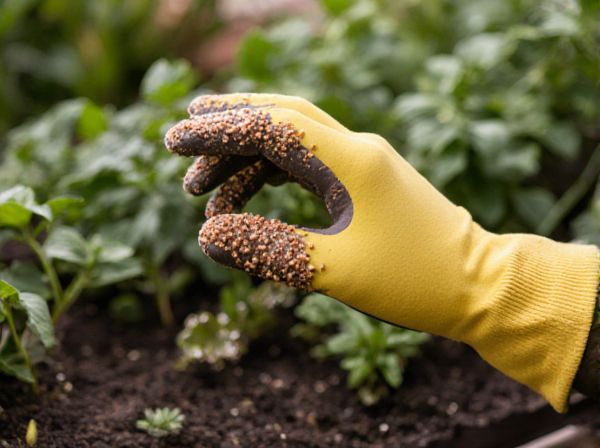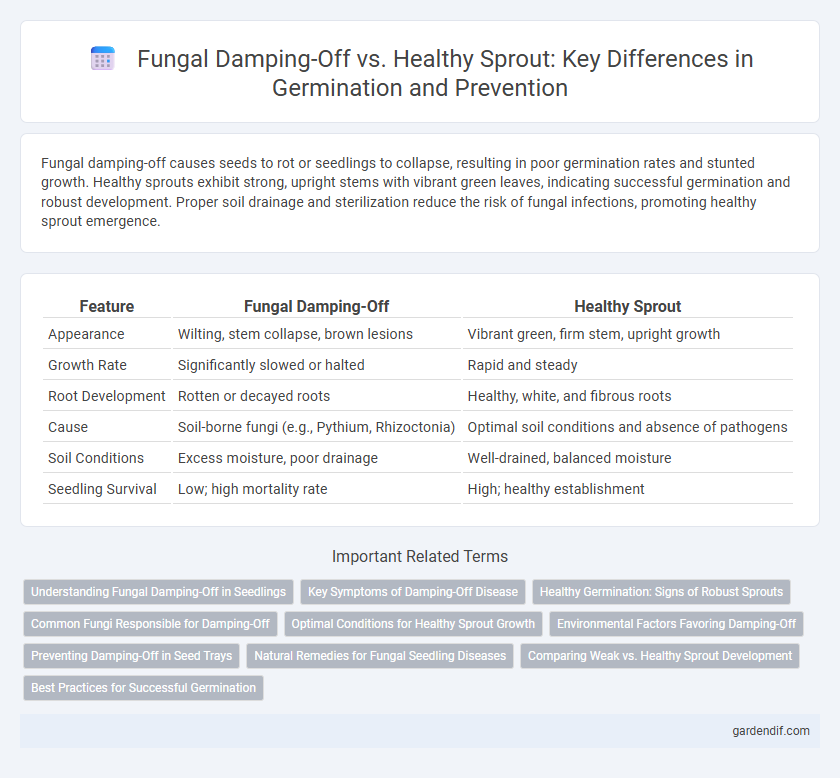
Fungal damping-off vs Healthy sprout Illustration
Fungal damping-off causes seeds to rot or seedlings to collapse, resulting in poor germination rates and stunted growth. Healthy sprouts exhibit strong, upright stems with vibrant green leaves, indicating successful germination and robust development. Proper soil drainage and sterilization reduce the risk of fungal infections, promoting healthy sprout emergence.
Table of Comparison
| Feature | Fungal Damping-Off | Healthy Sprout |
|---|---|---|
| Appearance | Wilting, stem collapse, brown lesions | Vibrant green, firm stem, upright growth |
| Growth Rate | Significantly slowed or halted | Rapid and steady |
| Root Development | Rotten or decayed roots | Healthy, white, and fibrous roots |
| Cause | Soil-borne fungi (e.g., Pythium, Rhizoctonia) | Optimal soil conditions and absence of pathogens |
| Soil Conditions | Excess moisture, poor drainage | Well-drained, balanced moisture |
| Seedling Survival | Low; high mortality rate | High; healthy establishment |
Understanding Fungal Damping-Off in Seedlings
Fungal damping-off is a common seedling disease caused by soil-borne pathogens such as Pythium, Rhizoctonia, and Fusarium species, leading to stem rot and collapse. In contrast, a healthy sprout exhibits vigorous growth with firm stems and green cotyledons, free from lesions or discoloration. Understanding fungal damping-off is crucial for effective seedling management, emphasizing proper soil drainage, sterilization, and fungicide application to prevent pathogen proliferation.
Key Symptoms of Damping-Off Disease
Fungal damping-off causes seedlings to collapse suddenly due to stem rot at or just below the soil surface, often resulting in water-soaked, brown lesions and a slimy appearance. Infected sprouts wilt and fail to develop healthy roots, contrasting with healthy sprouts that exhibit firm stems, vigorous growth, and normal root systems. Early detection of damping-off includes observing seedling discoloration, stunted growth, and the presence of fungal mycelium around the base.
Healthy Germination: Signs of Robust Sprouts
Healthy germination is characterized by vibrant green cotyledons, upright stems, and consistent growth rates, indicating strong seedling vigor and successful root establishment. Robust sprouts exhibit firm, turgid tissues free from discoloration or lesions, differentiating them clearly from fungal damping-off symptoms like stem collapse and root rot. Optimal soil moisture and sterile growing conditions further support the development of healthy seedlings resistant to common fungal pathogens.
Common Fungi Responsible for Damping-Off
Common fungi responsible for damping-off include Pythium, Rhizoctonia, and Fusarium species, which attack seeds and young seedlings, causing rot and collapse. These pathogens thrive in moist, poorly ventilated soil conditions, leading to weakened or dead sprouts often identified by discoloration, wilting, and stem lesions at the soil line. In contrast, healthy sprouts exhibit robust stem structure, vibrant coloration, and steady growth unaffected by such fungal infections.
Optimal Conditions for Healthy Sprout Growth
Optimal conditions for healthy sprout growth include well-drained soil with balanced moisture levels to prevent fungal damping-off caused by pathogens like Pythium and Rhizoctonia. Maintaining a temperature range of 20-25degC and ensuring adequate air circulation reduces the risk of fungal infections and supports vigorous seedling development. Proper seed sterilization and avoiding overcrowding also contribute to robust, disease-free germination.
Environmental Factors Favoring Damping-Off
High humidity, poorly drained soil, and cool temperatures create ideal conditions for fungal damping-off, significantly increasing the risk of seedling infection. Overcrowded planting and excessive watering promote spore germination and fungal growth, leading to stem lesions and seedling collapse. In contrast, well-drained soil, proper spacing, and moderate moisture levels support healthy sprout development by minimizing fungal pathogen activity.
Preventing Damping-Off in Seed Trays
Fungal damping-off in seed trays is caused by pathogens such as Pythium, Rhizoctonia, and Fusarium, which thrive in overly wet, poorly drained soil and high humidity conditions. Maintaining proper drainage and consistent airflow, along with using sterilized soil and fungicide treatments, significantly reduces the risk of fungal infection and promotes healthy sprout development. Seedlings that avoid damping-off exhibit strong stems, vibrant green leaves, and steady root growth, ensuring successful germination and early plant establishment.
Natural Remedies for Fungal Seedling Diseases
Fungal damping-off is a common seedling disease marked by stem rot and sudden wilting, often caused by soil-borne pathogens like Pythium, Rhizoctonia, and Fusarium species. Natural remedies such as neem oil, chamomile tea, and cinnamon powder have proven effective in controlling fungal growth and protecting germinating seeds. Implementing these biocontrol agents alongside good soil drainage enhances seedling health and reduces the incidence of damping-off in organic gardening.
Comparing Weak vs. Healthy Sprout Development
Fungal damping-off causes weak sprout development characterized by water-soaked, collapsed stems and inhibited root growth, leading to seedling death. Healthy sprouts exhibit robust stem elongation, vibrant green leaves, and extensive root systems essential for nutrient uptake and sustained growth. Early detection of fungal pathogens and optimal soil conditions promote healthy sprout development and reduce mortality rates during germination.
Best Practices for Successful Germination
Maintaining sterile soil and proper moisture levels reduces the risk of fungal damping-off, a common pathogen-induced disease causing seedling collapse. Using well-drained substrates, avoiding overwatering, and ensuring adequate airflow promotes healthy sprout development during germination. Applying fungicide treatments and practicing crop rotation further enhance seedling survival rates and overall germination success.
Fungal damping-off vs Healthy sprout Infographic

 gardendif.com
gardendif.com